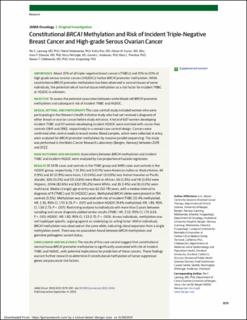| dc.description.abstract | Importance About 25% of all triple-negative breast cancers (TNBCs) and 10% to 20% of high-grade serous ovarian cancers (HGSOCs) harbor BRCA1 promoter methylation. While constitutional BRCA1 promoter methylation has been observed in normal tissues of some individuals, the potential role of normal tissue methylation as a risk factor for incident TNBC or HGSOC is unknown.
Objective To assess the potential association between white blood cell BRCA1 promoter methylation and subsequent risk of incident TNBC and HGSOC.
Design, Setting, and Participants This case-control study included women who were participating in the Women’s Health Initiative study who had not received a diagnosis of either breast or ovarian cancer before study entrance. A total of 637 women developing incident TNBC and 511 women developing incident HGSOC were matched with cancer-free controls (1841 and 2982, respectively) in a nested case-control design. Cancers were confirmed after central medical record review. Blood samples, which were collected at entry, were analyzed for BRCA1 promoter methylation by massive parallel sequencing. The study was performed in the Mohn Cancer Research Laboratory (Bergen, Norway) between 2019 and 2022.
Main Outcomes and Measures Associations between BRCA1 methylation and incident TNBC and incident HGSOC were analyzed by Cox proportional hazards regression.
Results Of 2478 cases and controls in the TNBC group and 3493 cases and controls in the HGSOC group, respectively, 7 (0.3%) and 3 (0.1%) were American Indian or Alaska Native, 46 (1.9%) and 30 (0.9%) were Asian, 1 (0.04%) and 1 (0.03%) was Native Hawaiian or Pacific Islander, 326 (13.2%) and 125 (3.6%) were Black or African, 56 (2.3%) and 116 (3.3%) were Hispanic, 2046 (82.6%) and 3257 (93.2%) were White, and 35 (1.4%) and 35 (1.0%) were multiracial. Median (range) age at entry was 62 (50-79) years, with a median interval to diagnosis of 9 (TNBC) and 10 (HGSOC) years. Methylated BRCA1 alleles were present in 194 controls (5.5%). Methylation was associated with risk of incident TNBC (12.4% methylated; HR, 2.35; 95% CI, 1.70-3.23; P < .001) and incident HGSOC (9.4% methylated; HR, 1.93; 95% CI, 1.36-2.73; P < .001). Restricting analyses to individuals with more than 5 years between sampling and cancer diagnosis yielded similar results (TNBC: HR, 2.52; 95% CI, 1.75-3.63; P < .001; HGSOC: HR, 1.82; 95% CI, 1.22-2.72; P = .003). Across individuals, methylation was not haplotype-specific, arguing against an underlying cis-acting factor. Within individuals, BRCA1 methylation was observed on the same allele, indicating clonal expansion from a single methylation event. There was no association found between BRCA1 methylation and germline pathogenic variant status.
Conclusions and Relevance The results of this case-control suggest that constitutional normal tissue BRCA1 promoter methylation is significantly associated with risk of incident TNBC and HGSOC, with potential implications for prediction of these cancers. These findings warrant further research to determine if constitutional methylation of tumor suppressor genes are pancancer risk factors. | en_US |

